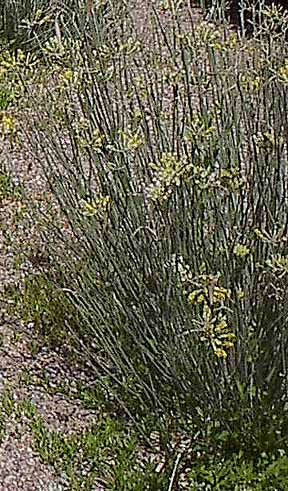
Lake Mead RV landscape showing seepwillow hedge as well as an Ash tree, and several low bushes, planted April 2004 (Photo May 2005) For more about the green mat at the base of the Ash, see below.
Native hedges & more < previous 1 | 2
Shade is a particularly important component of landscapes in the desert, however it is not the only consideration. Large open spaces in the Mojave desert leave sites open to both wind and prying eyes. Hedges are an answer. Low bushes also help to add variety of form, making landscapes more 3 dimensional. Flowers appeal to both the senses of sight and smell, while attracting wildlife such as butterflies and humming birds.
In the past, hedges and flowers at Lake Mead have been provided by Oleander. In addition to being nonnative, this species poisonous and a spreading weed where water is available. Several native species are being experimented with as replacements for Oleander.
Sticky Seepwillow is one of the most promising alternatives being considered. While it does not have the showy flowers of Oleander, it grows rapidly and thickly making an excellent hedge, as seen in photos above and right. In fact, after the hedge at Lake Mead RV was planted, the manager reported that residents of his camp accused him of planting Oleander when he'd told them that they couldn't . If the public has a hard time distinguishing the two, then Seepwillow is a good replacement.
Seepwillow weeds at base of the Ash in photo at top __Seedlings not suckers
Unfortunately as the photo above shows, seepwillow has the potential to become a weed itself in landscapes if too much water is made available. Since it is native, spread into the park from developed areas is less of a concern. However as a landscape weed it can greatly increase the amount of maintenance a site requires. In the photo from Callville Bay (above right) seepwillow is not being weedy because much less water is being used on that site. So the weedyness of this species in landscapes can be controlled through water management.
The list of plants with ornamental value that are native to Lake Mead is quite long, however just two more will be focused on here.
Brittlebush is the first, shown above right. In addition to attractive flowers which it produces seasonally with the rains, Brittlebush offers an attractive shape and colorful leaves, both of which are on display year round. It is also a very tough plant, able to survive extended periods with very little water, yet is unharmed by over-watering
Rush Milkweed is the second, shown at right. While not conventionally beautiful, it has a strikingly distinctive form, and attractive flowers. Like Brittlebush it is quite hardy, and tolerant of abuse making it an easily maintained plant.
< previous 1 | 2
 __
__



